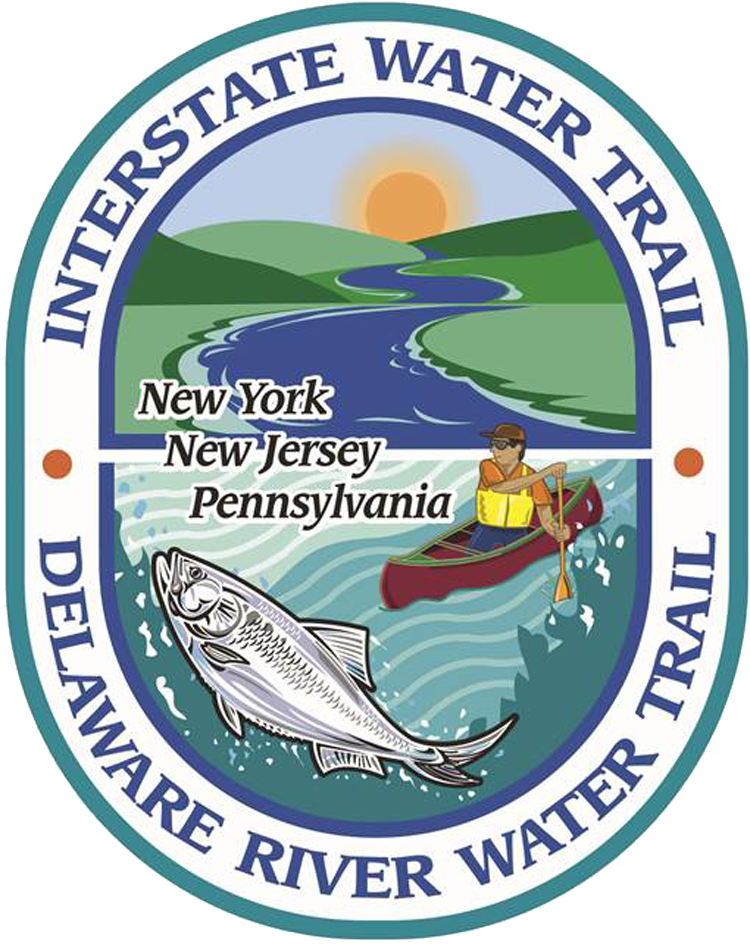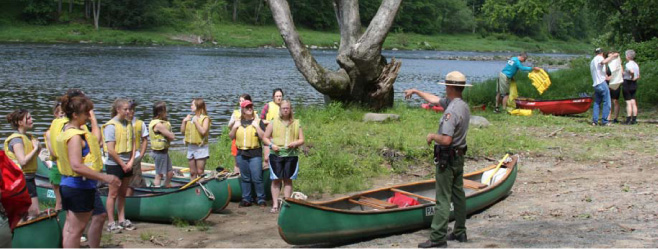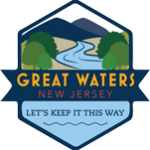The Delaware River is a great place to relax and enjoy nature, but as with many outdoor activities there are inherent risks that can lead to injury or even death. River enthusiasts bear personal responsibility for their own safety. Always remember the ever-changing nature of the river. Pay close attention to weather conditions. Use common sense, caution, good planning and proper equipment to greatly reduce risks.
A wealth of information is available on river safety issues and techniques. One of the best ways to learn about safety and improve skills is to join a local paddling or boating club. Experienced boaters are eager to share their knowledge and demonstrate efficient, safety-minded techniques and skills. There are also some excellent books and videos available. The American Canoe Association offers paddling courses for all skill levels for both canoe and kayak, and the National Canoe Safety Patrol offers river safety and rescue courses. The U.S. Coast Guard Auxiliary offers similar programs for motor boaters.
The following tips will help ensure safe and enjoyable river trips:
BE PREPARED — WEAR YOUR LIFE JACKET
Never enter the river without wearing a Personal Flotation Device (PFD) or lifejacket.
Always carry some form of personal identification and notation of medical conditions and allergies. Always carry water and a first-aid kit, and an extra paddle if you are in a canoe or kayak. In cool weather, dress accordingly and bring at least a complete change of warm clothing in a waterproof bag. In warmer weather take along insect repellent and sun block. Plan your trip carefully and seek out the latest information on ever changing river conditions. Let someone know what your plans are and when you expect to be finished. Always wear protective footgear. Watch for broken glass underfoot, particularly near accesses.
CONSIDER YOUR SKILL LEVEL
The Delaware River’s flat water stretches are perfect for beginners. Class I & II rapids are appropriate for more experienced paddlers. Class II stretches of this river are often considered “technical,” which refers to the degree of boat-handling skill required to navigate rocks and boulders in swiftly moving current. Be aware that class designations are relative to changes in water levels. Make sure your paddling adventures are in sync with your skill level.
IN AN EMERGENCY
Save People First! Equipment can be salvaged later. Even a swamped boat will float. Stay with it. Try to keep hold of your paddles if you are in a canoe or kayak. Hold on to the upstream end of the boat to avoid getting caught between the boat and a rock. Float on your back, with your feet pointing downstream near the surface to avoid foot entrapment in the rocks. Swim over to the riverbank. If possible, retrieve your boat in safe, calm water. Never stand up in the mainstream or current. In the event of an emergency, call 911 or local authorities.
SWIMMING AND WADING
Hot summer days invite river users to cool off. Be aware that most drownings on the river have been swimming-related. Always keep your PFD or lifejacket on. Swift currents, sudden drop-offs, and slippery rocks can cause unexpected and serious injuries. Don’t wade in water above your knees in a strong current. You can be knocked over or your foot could be caught between rocks. If you’re swimming in a current, keep your feet downstream and elevated toward the surface. Then you can see what’s ahead of you and can use your feet to ward off some of the rocks.
ELEVATED RIVER LEVELS
At elevated river levels mandatory wear of a life jacket is required. Always check the river level before you go.
TRAVEL SMART
Don’t travel alone. Let someone know your trip plans.
COLD
Even during June and September, when the weather seems mild, hypothermia can be a problem for the unprepared river traveler. Wear synthetic fleece or wool, or special gear (i.e., wet suits or dry suits) for thermal protection. At the very least, bring along a complete change of clothing in a dry-bag or double-bag your clothes with black plastic trash bags. Tie gear securely to the boat.
STRAINERS
Strainers are fallen trees or debris piles that block all or a portion of the river. Like a kitchen strainer, a river strainer lets water through, but not you or your boat. Avoid strainers at all costs!
Strainers commonly occur along the banks of the river where one or more trees have fallen into the water but they may be found anywhere along the river. In some cases a strainer will block the entire channel. Be alert for strainers, especially where the river narrows, and around sharp bends where strainers may loom with little time to react.
A special kind of strainer called an Eel Weir can be found in the Upper Delaware. Paddle around eel weirs . These are V-shaped wooden and rock walls in the channels, pointing downstream, usually constructed by late summer. Besides catching eels they can also trap and swamp your boat. Watch for the posted signs and avoid them.
If you do get caught by a strainer, keep calm. Lean to the downstream side, even though that means leaning towards the tree or obstacle. If in a canoe, make sure you coordinate your moves with each other. Don’t try to swim — you could be crushed under the canoe.
BRIDGES
Bridge piers are common collecting points for strainers. Because of the strong current, avoid the piers themselves and give the surrounding area a wide berth, as parts of the piers may extend far under the water. Anticipate your approach from a far distance to stay clear of the piers.


